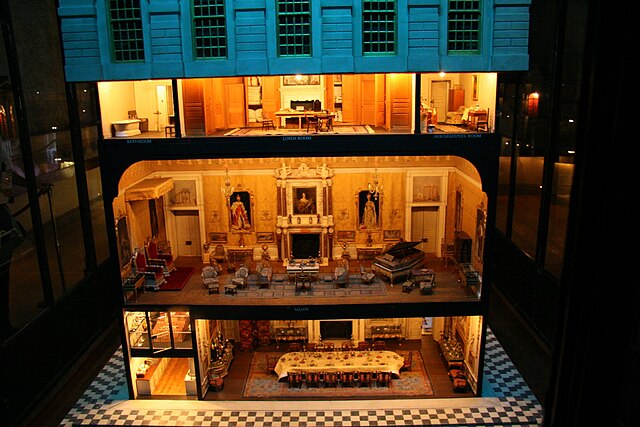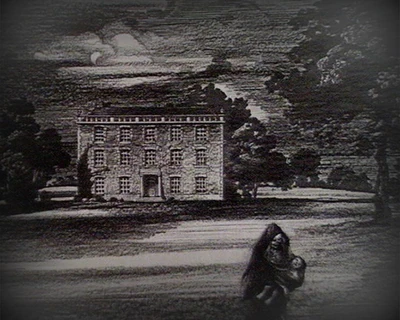
Wikimedia Commons
“The Haunted Dolls’ House” is a horror story by the English medievalist and author M. R. James (1862–1936), first published in the magazine Empire Review in 1923.[2] It was included in his A Warning to the Curious and Other Ghost Stories Collection of six short stories by the English medievalist and author M. R. James, first published in 1925., published in 1925.
Collection of six short stories by the English medievalist and author M. R. James, first published in 1925., published in 1925.
The story concerns the tiny model inhabitants of a dolls’ house that come to life and reenact an apparent murder scene, and is told as a third-person narrative.
Synopsis
The story begins in Mr Chitterden’s shop, where he is negotiating the sale of a dolls’ house to Mr Dillet. A price is agreed, and Dillet leaves with the dolls’ house, to the relief of Chitterden’s wife, who says she is glad it is gone, and especially to Dillet, who in her opinion would be “none the worse for a bit of a shake up”.
Once home, Dillet examines his purchase in detail, a dolls’ house in Strawberry Hill Gothic, six feet (1.8 m) long, with a chapel or oratory to the left and a stable to the right. It contains several dolls: a middle-aged couple, two children, an old man in bed, and various servants. After setting up the dolls’ house on a table in his room, Dillet retires to bed. He is soon woken by the sound of a bell tolling one o’clock, and sees the dolls’ house now looking like a real house in a real landscape, with lights in the windows and real inhabitants.
Dillet sees the lady of the house visit the old man in his bedroom, and she and a nurse make him drink a posset Drink made from milk curdled by the addition of an acidic liquid such as wine or ale, which evolved into an early form of trifle., following which he has a fit and dies. A man in black arrives in a coach carrying a small box of papers, which he leaves with the man and his wife before driving off. As Drillet continues to watch the dolls’ house he sees a second scene, a black coffin surrounded by four tall candles. The father jokingly frightens the children by pretending to be a ghost, but then a man-sized frog-like creature enters their darkened bedroom. “The sound of cries – faint, as if coming out of a vast distance – but, even so, infinitely appalling, reached the ear.” Dillet sees the house in commotion, and again hears the clock tolling one.
Drink made from milk curdled by the addition of an acidic liquid such as wine or ale, which evolved into an early form of trifle., following which he has a fit and dies. A man in black arrives in a coach carrying a small box of papers, which he leaves with the man and his wife before driving off. As Drillet continues to watch the dolls’ house he sees a second scene, a black coffin surrounded by four tall candles. The father jokingly frightens the children by pretending to be a ghost, but then a man-sized frog-like creature enters their darkened bedroom. “The sound of cries – faint, as if coming out of a vast distance – but, even so, infinitely appalling, reached the ear.” Dillet sees the house in commotion, and again hears the clock tolling one.
In the final scene Dillet sees two small coffins being carried out of the house. The experience so unnerves him that he consults with his doctor, who advises that he take a holiday on the east coast, where he again meets Chittenden, recovering from his own experience of the same vision. They agree that the man in black was a lawyer bringing a draft will, and Chittenden says he thinks the dolls’ house originated somewhere close by, prompting Dillet to investigate.
Dillet examines the Canterbury and York Society’s collection of the parish registers for the area, and discovers records of the burial of Roger Milford, aged 76, on 11 September 1757, and of Roger and Elizabeth Merewether, aged 9 and 7, eight days later. The Merewether family lived in Ilbridge House, in the parish of Coxham, and Dillet decides to visit. He finds the house in ruins and quite unrecognizable, but as he is leaving the village the church clock strikes four: “It was not the first time he had heard that bell”.
Commentary
Towards the end of the story Chittenden comments:
James was well aware that he might be accused of recycling his story of “The Mezzotint Horror story by M. R. James, first published in 1904, about an engraving that changes every time it is looked at.“, published nineteen years earlier, in which the characters in a picture come alive, but he hoped that “there is enough of variation in the setting to make the repetition of the motif tolerable”.[2]
Horror story by M. R. James, first published in 1904, about an engraving that changes every time it is looked at.“, published nineteen years earlier, in which the characters in a picture come alive, but he hoped that “there is enough of variation in the setting to make the repetition of the motif tolerable”.[2]
References
Works cited
External links
- Full text of “The Haunted Dolls’ House” at Project Gutenberg


